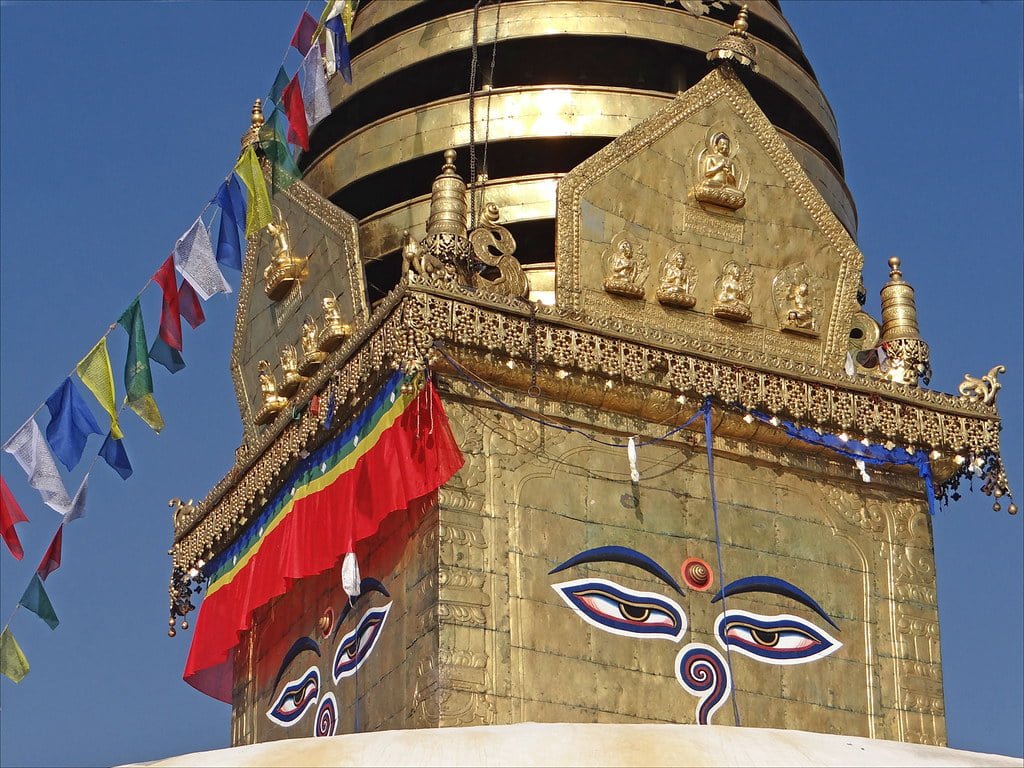Swayambhunath Stupa
History of Swayambhunath Stupa
The Swayambhunath Stupa, located in Nepal, holds a rich history that dates back over 2,000 years. It is considered the oldest known stupa in Nepal and is believed to have been founded by King Vrsadeva, the great-grandfather of King Manadeva. The exact date of its construction remains unknown, but evidence of its existence can be traced back to the 5th century.
During the Licchavi period (400-750 CE), several shrines and temples were built around the Stupa, adding to its significance and beauty. These structures were constructed by devotees to pay homage to the Stupa and enhance the religious atmosphere of the site.
One remarkable aspect of Swayambhunath is its harmonious coexistence of Buddhism and Hinduism. The Buddhist stupa is surrounded by Hindu temples, making it a unique religious site where both Buddhists and Hindus come to worship. This symbolizes the unity and tolerance between these two religions and serves as an example for others to follow.
The Swayambhunath Stupa is also known as the Monkey Temple due to its large population of monkeys. These monkeys are considered “holy monkeys” and are an integral part of the religious and cultural significance of the site.
To reach the Stupa, visitors must ascend 365 steep stone steps, providing a challenging workout for those who choose to climb. However, for those who prefer to avoid the stairs, there is a direct car entrance to the top.
In recognition of its historical and cultural significance, Swayambhunath was declared a UNESCO World Heritage site in 1979. This designation further highlights the importance of preserving and protecting this ancient religious monument for future generations.
Three main festivals are celebrated at Swayambhunath: Gunla, Buddha Jayanti, and Lhosar. Gunla is the most important and month-long festival celebrated by Newar Buddhists. It is a time of spiritual reflection and retreat, enhancing the religious atmosphere of the Stupa.
The history of Swayambhunath Stupa is intertwined with legends and stories passed down through generations. One popular myth tells the tale of how the Kathmandu Valley was once a lake until the Bodhisattva Manjusri, in his wisdom, cut a gorge at Chobhar with his sword, allowing the lake to drain and making Swayambhunath accessible to pilgrims.
As one explores the Swayambhunath Stupa, its ancient origins and the layers of history become apparent. It stands as a testament to the devotion and spirituality of the people of Nepal and continues to be a sacred and revered site for both Buddhists and Hindus alike.
Structure and Design
The Spire and Dome
One of the most captivating aspects of the Swayambhunath Stupa is its majestic spire and dome. Rising through a whitewashed dome to a gilded spire, this architectural masterpiece is a symbol of wisdom and enlightenment.
The spire and dome of the Swayambhunath Stupa are not only visually striking but also deeply symbolic. The white dome represents the earth, symbolizing the grounded nature of the Buddha’s teachings. It reminds visitors of the importance of staying connected to the earth and finding balance in their lives.
At the top of the dome is a 13-tiered, tower-like structure that symbolizes the 13 stages to nirvana. This intricate design signifies the spiritual journey towards enlightenment and serves as a reminder of the ultimate goal for Buddhists.
One cannot help but be captivated by the four iconic faces of the Buddha that stare out across the valley in the cardinal directions. These all-seeing eyes represent the wisdom of the Buddha, constantly watching over and guiding those who visit the stupa. The piercing gaze of the Buddha’s eyes gives a sense of awe and reverence, creating a spiritual ambiance that is truly unique.
The entire structure of the stupa, including the spire and dome, is a testament to the rich architectural heritage of the Kathmandu Valley. Despite being shaken severely by the devastating earthquake in 2015, the main stupa sustained only superficial damage. This resilience is a testament to the craftsmanship and engineering that went into its construction.
Visitors to the Swayambhunath Stupa can stand in awe of the spire and dome, marveling at the intricate details and the symbolism behind them. The grand white-washed structure, topped with a gilded spire and adorned with the all-seeing eyes of the Buddha, radiates the wisdom and enlightenment of the Buddha.
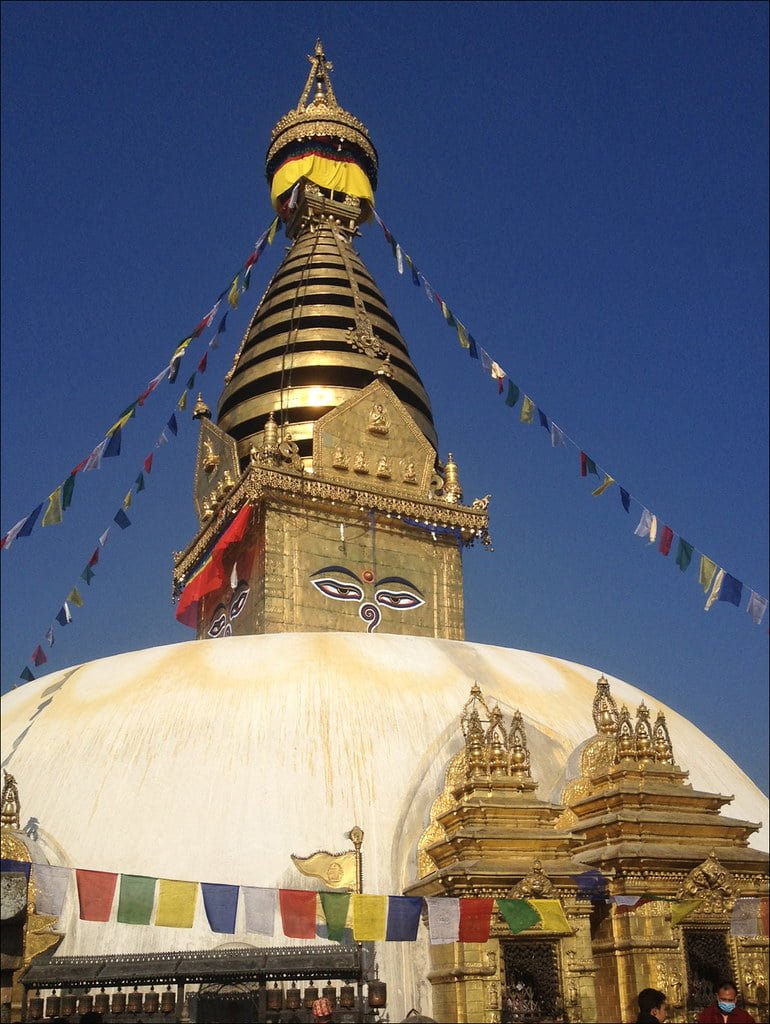
The All-Seeing Eyes
At the heart of the iconic Swayambhunath Stupa in Kathmandu, Nepal, lies a captivating symbol that has come to define this sacred site – the all-seeing eyes of Buddha. Painted on all four sides of the stupa’s gleaming golden spire, these eyes hold deep symbolism and carry profound significance for both scholars and devotees alike.
According to scholars, the wide-set eyes represent divine wisdom and the omniscience of enlightened beings. They are said to depict a key moment in Buddhist mythology when Buddha, after emerging victorious from the battle against Mara’s demon army, stared unblinking for seven days. This unwavering gaze symbolizes supreme awareness and the ability to perceive the true nature of reality.
For the faithful, the Eyes of Buddha serve as a constant reminder of the enlightened presence that watches over and protects the Kathmandu Valley from harm. They are believed to possess a power that transcends time and space, offering guidance and inspiration to all who encounter them. These eyes are seen a source of spiritual awakening, inviting individuals to cultivate inner wisdom and strive towards enlightenment.
Beyond their spiritual significance, the eyes also carry a visual allure that adds to the aesthetic beauty of the stupa. Vibrant colors and intricate details bring these eyes to life, mesmerizing visitors with their captivating gaze. As one gazes upon them, a sense of serenity and tranquility washes over, creating a connection between the observer and the spiritual realm.
The Eyes of Buddha are not merely an artistic representation but also hold deeper metaphysical meaning. They are a powerful symbol of the cyclical nature of existence, depicted through vibrant floral and animal motifs adorning the stupa. These motifs symbolize samsara, the endless cycle of birth, death, and rebirth. They serve as a potent reminder of the impermanence of life and the necessity of seeking enlightenment to break free from this cycle.
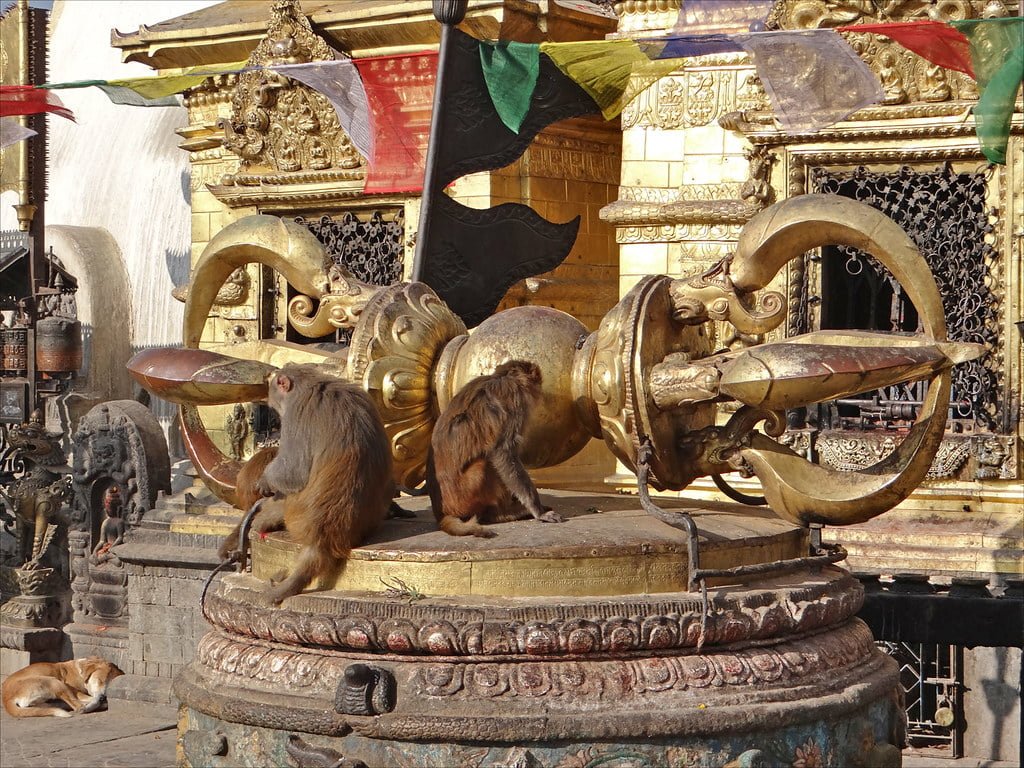
Religious Significance
Buddhist Pilgrimage Site at Swayambhunath: A Sacred Journey to Spiritual Enlightenment
Swayambhunath, also known as the Monkey Temple, is one of the oldest and most revered Buddhist pilgrimage sites in Nepal. Located on a hill in the western direction of Kathmandu city, this ancient site holds great religious and cultural significance for both Newar and Tibetan Buddhists.
The Tibetan name for Swayambhunath, “Phakpa Shingkun,” translates to “Sublime trees,” reflecting the abundance of various tree species found on the hill. These lush surroundings create a serene and peaceful atmosphere, making it an ideal place for spiritual contemplation and meditation.
According to historical records, the magnificent Swayambhunath stupa was built by King Manadeva, as inscribed on a stone found at the site. This imposing structure, with its iconic dome-shaped stupa and tiered golden spire, is a symbol of spiritual peace and enlightenment. It stands as a testament to the rich history and deep-rooted Buddhist heritage of Nepal.
For over 2,000 years, Swayambhunath has been a major pilgrimage site for Buddhists from all over the world. Its allure lies not only in its religious significance but also in the unique blend of Tibetan, Hindu, and Buddhist cultures that coexist here harmoniously.
Originally a Buddhist sacred site, Swayambhunath gradually transformed as Hindu and Buddhist traditions intertwined. The Buddhists embraced the Hindu goddess Harati (Ajima) as their protector against epidemics and diseases, while Hindu temples and Buddhist chaityas were built around the main stupa, creating a diverse and inclusive spiritual environment.
Iconography and Symbolism
Swayambhunath Stupa, also known as the Monkey Temple, is not only a significant religious site but also a treasure trove of iconography and symbolism. Every element of the stupa, from its structure to the intricate artwork, holds deep meaning and represents important aspects of Buddhist beliefs and teachings.
The entire stupa itself is symbolic, starting from its massive white dome to the gilded spire. The white dome represents the earth, signifying the grounded nature of Buddhism. It reminds us of our connection to the physical world and the importance of staying rooted in our actions and beliefs. The gilded spire, on the other hand, represents the 13 stages to nirvana, which is the ultimate goal of Buddhist practice.
One of the most recognizable symbols of Swayambhunath is the pair of eyes painted on all four sides of the stupa’s spire. These eyes are often referred to as Buddha’s eyes and represent divine wisdom and the omniscience of enlightened beings. They symbolize the ability to see beyond the physical world and perceive the true nature of reality. The eyes also serve as a constant reminder to practitioners to cultivate mindfulness and awareness in their lives.
The nose-like structure in between the pair of eyes is the Nepali number “Ek,” which means “one.” This represents the unity and oneness of all things, emphasizing the interconnectedness and interdependence of all beings. It serves as a reminder that we are all part of a greater whole and should strive for harmony and compassion in our interactions with others.
The stupa’s location atop a hill and its panoramic view of the Kathmandu valley also hold symbolic significance. The hill represents the lotus that was transformed from the primordial lake by the Bodhisattva Manjushri. It symbolizes the journey of spiritual transformation and enlightenment. The panoramic view from Swayambhunath represents the all-seeing perspective of Buddha’s eyes, gazing upon the world in all directions. It reminds us of the importance of cultivating a broad and inclusive perspective in our lives, embracing the diversity and interconnectedness of all beings.
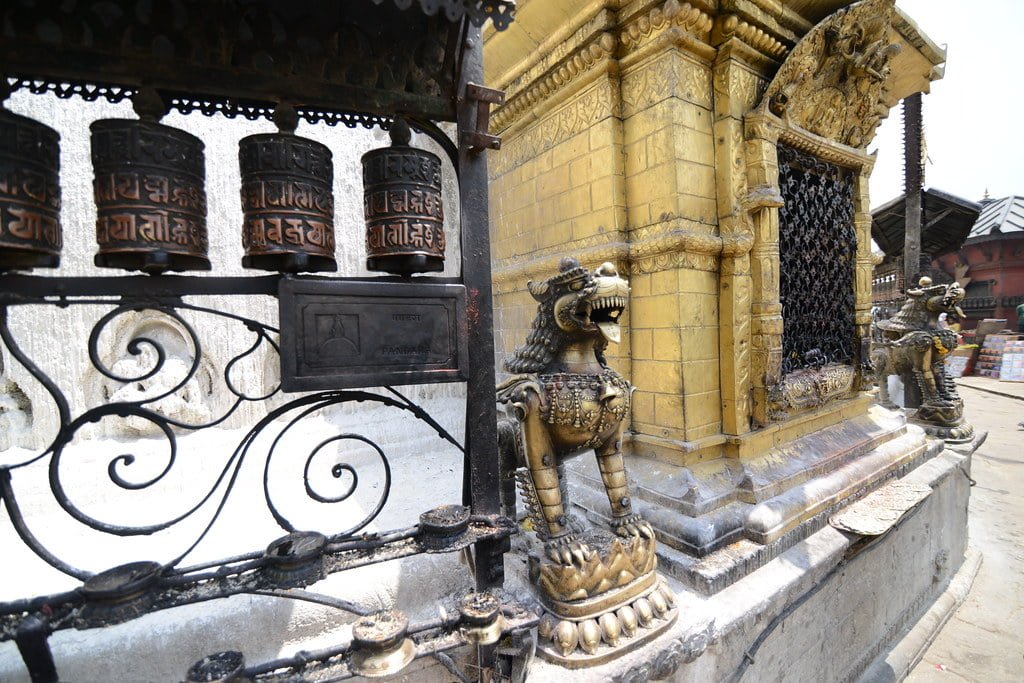
Exploring the Temple Complex
Shrines and Statues
One of the most remarkable aspects of Swayambhunath Stupa is the abundance of shrines and statues that surround the area. These sacred structures and symbols hold significant religious and cultural importance, adding to the spiritual ambiance of the site.
One notable shrine is the Harati Devi Temple, located on the northwestern side of the stupa. This Hindu temple is dedicated to Harati, the Goddess of smallpox and protector of all children. Its presence within the Buddhist complex signifies the harmonious intermingling of Hinduism and Buddhism in Nepal.
Apart from Harati Devi Temple, there are numerous other shrines and temples scattered around the stupa. Each one showcases unique architectural styles and religious iconography. These structures serve as places of worship and meditation for both Buddhists and Hindus.
The Five Dhyani Buddhas, representing the five cosmic elements, can be found around the base of the stupa. These statues symbolize the unity of all things and include Akshobhya (water), Ratnasambhava (earth), Amitabha (fire), Amoghasiddhi (air), and Vairocana (ether). Each Buddha is accompanied by their consort, further emphasizing the balance and harmony that permeates the Buddhist philosophy.
The shrines and statues at Swayambhunath Stupa also reflect the diverse religious beliefs present in Nepal. Tantric and shamanistic deities, as well as prayer wheels for Tibetan Buddhists, can be seen in the small shrines. Some of the stone chaityas are actually Shiva lingams, disguised as Buddhist structures and adorned with the faces of the Dhyani Buddhas. This blending of different religious traditions highlights the inclusive nature of spirituality in Nepal.
Accessible Crystal Stupa: A Jewel on the Hilltop
Originally, the crystal stupa was only accessible to a select few, as it stood atop a hill surrounded by a lake. However, a Buddhist monk from China played a pivotal role in making the stupa accessible to all people. He drained the lake, allowing devotees and visitors from various parts of the world to reach the sacred stupa.
Today, the Swayambhunath Temple complex stands as a testament to the centuries of reverence and devotion bestowed upon the crystal stupa. Buddhist masters from India, Sri Lanka, Tibet, and China have visited this iconic site, leaving their mark in the form of shrines, statues, and monasteries that sprawl across the grounds.
Amidst this Buddhist complex, a temple dedicated to Manjusri or Saraswati, the Hindu goddess of learning, can be found behind the hilltop. This harmonious blend of Buddhist and Hindu influences is a testament to the rich cultural diversity of the region.
The centerpiece of Swayambhunath is the magnificent stupa itself. This dome-shaped structure houses holy Buddhist relics and is perched atop a square platform. At its pinnacle, a gilded cube with the painted eyes of Buddha looks out in all four directions. Rising above the cube is a three-tiered tower that tapers to a spire, encircled by 13 golden rings symbolizing the path to enlightenment. The entire structure is adorned with hundreds of prayer flags that flutter in the wind, adding a sense of spirituality and grandeur to the stupa.
Underground Chamber at Swayambhunath Stupa: A Mysterious Realm of Spiritual Power
Deep within the sacred grounds of the Swayambhunath Stupa in Nepal lies a hidden treasure, an underground chamber shrouded in mystique and spiritual significance. Known as Shantipur, meaning the “Place of Peace,” this secret temple holds a profound connection to the ancient Tantric traditions of Nepal.
Legend has it that in the 5th century, the renowned Tantric master Shantikar Acharya sealed himself inside the underground chamber beneath the temple, embarking on a spiritual journey that would lead him to attain an immortal state. Even today, devotees believe that Shantikar Acharya continues to reside within these hallowed walls, engaged in deep meditation and holding immense power over the weather.
Access to the underground chamber is strictly restricted to Buddhacharya priests, who alone possess the privilege of entering this hidden realm. Ordinary visitors are permitted only as far as the porch, where they can catch a glimpse of the temple’s enigmatic aura. The chamber itself remains forever locked, its secrets preserved within its ancient walls.
One of the most captivating aspects of the underground chamber is its connection to the Swayambhunath Stupa. It is believed that Shantipur covers the entrance to an intricate network of rooms that intertwines with the hidden core of the stupa. This interconnection symbolizes the deep spiritual bonds between Buddhism and the esoteric traditions of Newar Buddhism.
The significance of the underground chamber extends beyond its physical location and historical context. The chamber is said to house a secret mandala, a sacred geometric design that holds immense spiritual power. In times of drought and other natural calamities, the King of Nepal would venture into the underground chamber to seek the assistance of Shantikar Acharya and obtain the secret mandala. Once the mandala is brought outside and shown to the sky, it is believed that it has the ability to bring about the much-needed rain and restore harmony to the land.
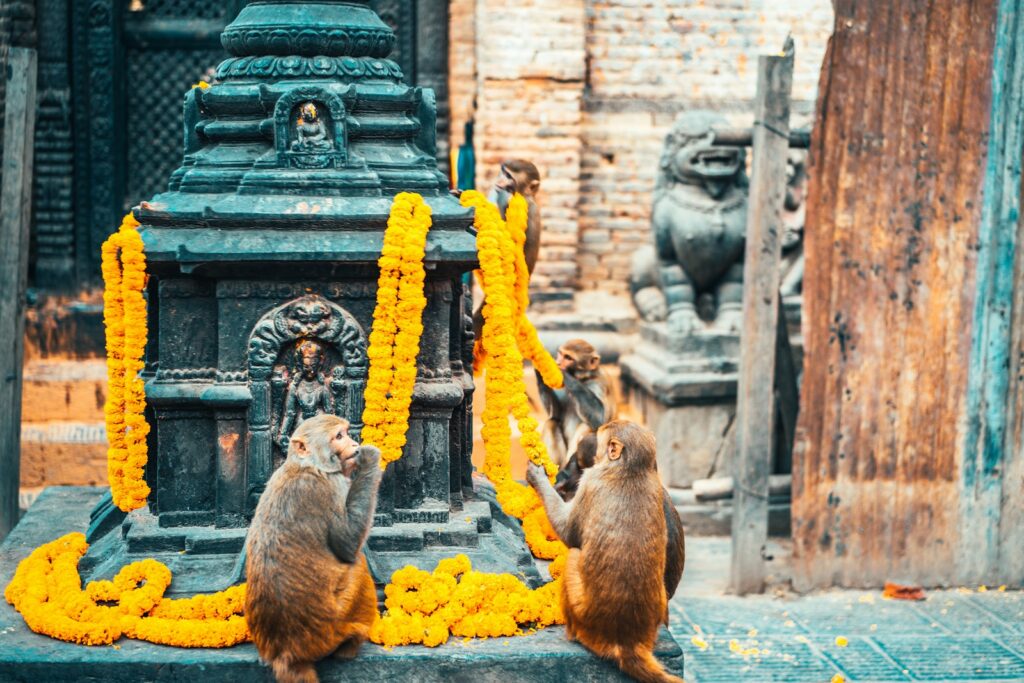
Visiting Swayambhunath Stupa
Directions and Location
To reach Swayambhunath, there are two access points. The first is a long staircase that leads directly to the main platform of the temple, located at the top of the hill to the east. This staircase can be quite steep and challenging, but it offers a scenic and immersive approach to the temple. As you ascend the stairs, you will pass through a vibrant and bustling market area with shops, restaurants, and hostels.
The second access point is a car road that goes around the hill from the south and leads to the southwest entrance of Swayambhunath. This road provides a more convenient option for those who prefer to drive or have limited mobility.
Once you reach the top of the stairway or enter through the southwest entrance, you will be greeted by the magnificent Swayambhunath Stupa, which is the main focal point of the complex. The stupa is adorned with Buddha’s eyes and eyebrows, with the number one painted in the form of a nose. This iconic symbol represents the all-seeing and all-knowing nature of Buddha.
Nearby Attractions
Here are some nearby attractions that you can visit while exploring the area:
- Pashupatinath: Located near the eastern edge of Kathmandu, Pashupatinath is one of the most important Hindu temples dedicated to Lord Shiva. It is a sacred pilgrimage site and a center for Hindu rituals and cremations.
- Boudhanath: Known as the Boudha Stupa, this magnificent Buddhist shrine is one of the largest stupas in the world. It is an important pilgrimage site for Buddhists and offers a peaceful and spiritual atmosphere.
- Patan Durbar Square: Situated in the city of Lalitpur, Patan Durbar Square is a UNESCO World Heritage Site that showcases the traditional architecture and rich history of the area. It is home to numerous temples, palaces, and courtyards.
- Nagarkot: A scenic hill station located on the outskirts of Kathmandu, Nagarkot offers stunning panoramic views of the Himalayas. It is a popular destination for sunrise and sunset views and is a great place for hiking and photography.
- Bhaktapur: Known as the “City of Devotees,” Bhaktapur is an ancient city with well-preserved architecture and a rich cultural heritage. The Bhaktapur Durbar Square is a UNESCO World Heritage Site and is home to numerous temples, palaces, and traditional Newari architecture.
- Patan Museum: Situated in the city of Patan, the Patan Museum is a must-visit for art and history enthusiasts. It houses a collection of ancient artifacts, sculptures, and religious art that showcase the artistic brilliance of the region.
- Garden of Dreams: Located in Kathmandu, the Garden of Dreams, also known as Swapna Bagaicha, is a beautifully restored garden that offers a peaceful escape from the bustling city. It features lush greenery, ponds, pavilions, and stunning architecture.
These nearby attractions offer a diverse range of cultural, historical, and natural experiences that complement the spiritual significance of Swayambhunath. Whether you are interested in Hindu and Buddhist religious sites, ancient architecture, or scenic views, the Kathmandu Valley has something to offer for every traveler.

